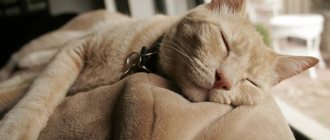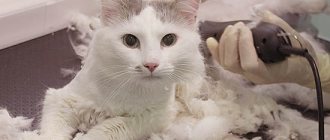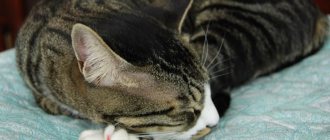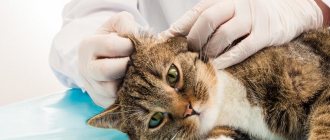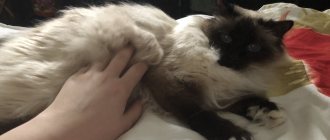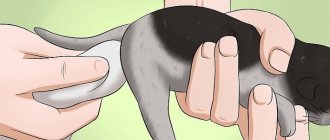Which animals are not recommended for the procedure?
There is no need to trim the claws of a cat that roams freely outside. She needs her nails to climb trees, hunt and defend herself from other four-legged animals.
Also, the procedure is not performed on kittens under 1 month of age. Their claws are not yet formed. Early cutting negatively affects the structure of the nail plate and leads to delamination.
But already at 2 months the claws are strongly extended, and the kitten begins to scratch. At this time they can already be cut.
Why cut your hair?
Cats that live or are often outside wear down their claws naturally on trees and the ground. They also need sharp claws to defend themselves from enemies and get food. If a cat lives in a house or apartment, it does not have such a need. But instincts cannot be avoided, and the animal sharpens its claws on furniture and walls. And during active games it can injure the owners.
Excessive claw length can also cause discomfort to the animal itself. The floor surface in a house or apartment is not as soft as the ground. And when your pet steps on the floor with its paws, it may cause discomfort.
© shutterstock
Also, long claws on the fifth toes of the front paws may begin to grow in. This will lead to inflammation and will require medical intervention and treatment.
What tools can you use?
There are special nail clippers for trimming cat claws. It is not recommended to use nail scissors. They are designed for thin and flat nail plates of people. Such cutting tools lead to delamination.
There are several types of nail clippers:
- Blisters - resemble nail scissors, but have blades curved at the ends, designed for cat claws.
- Secateurs are equipped with a spring, which is located between the handles. As a rule, such models have a limiter. It allows you to cut only the desired length.
- Guillotines are similar to cigar scissors. The nail is placed in the hole at the end. When the handles are closed, the blade lowers and cuts the claw. The tool is suitable for cats with thick nail plates.
Each owner chooses the model that is convenient for him to use. The main thing is that it is made of high-quality materials and sharpened.
Additionally, you can buy an electric trimmer that allows you to quickly trim your nails. However, not all cats react calmly to it - the buzzing device scares the animals.
Important. When cutting, the blade of the guillotine nail clipper must move from bottom to top, otherwise the risk of crushing the nail increases. This is especially dangerous for kittens whose claw plates are not yet strong enough.
Types of nail clippers
There are many types of this tool for cat manicure, but most of them belong to one of five groups:
- Scissors. In appearance and structure they really resemble a familiar instrument. Only the blades are very short, made of thick and durable steel and have special grooves for a tight grip on the claw.
- Nippers or secateurs. The operating principle is similar to pliers or pruning shears. They have the same rubberized, widely spaced handles, usually connected by a spring. They end with the same blades with rounded notches. The knives of this accessory are locked using a lever, which makes them safe for storage, especially if there are small children in the house. Most models are also equipped with claw length limiters, which minimizes the risk of injury to the animal.
- Guillotine type. The operating principle of this device is the same as that of the legendary execution weapon of the French Revolution. The tip of the cat's claw is secured in the device and a sharp knife is lowered, cutting off the dead part. This is one of the most popular types today. True, you need to use such a nail clipper very carefully, since the entire length of the clamped nail plate is not visible. In addition, reviews of devices of this type are often negative; people prefer scissors or pruning shears.
- Electric grinders. Most often, this tool is used by professional groomers in pet salons. The tip of the claw grinds down on the rotating abrasive part of the device. Such a grinding machine usually has several different attachments and has limiters on the length of the nail plate.
- With claw catchers. They can be of different types, for example, guillotine. Equipped with a device that absorbs the severed part of the claw.
How often is nail trimming done?
The frequency of haircuts depends on the individual characteristics of the cat. For some, it is enough to carry out the procedure once a month, for others – every 2-3 weeks.
As a rule, light-colored nails grow faster. And in cats that prefer active games, partial wear occurs naturally. To determine the exact timing, you just need to carefully observe your pet.
For your information. A cat needs to have its claws trimmed before an exhibition, competition or other important event.
Preparing for the first procedure
To trim a cat's claws with minimal stress, the animal is first accustomed to this procedure. It is better to start doing this in childhood. Kittens adapt to any changes more easily than adults.
For your information. There are cases where adult cats, accustomed to clinging with their claws while jumping, have fallen and been injured due to the fact that their nails were suddenly cut.
Preparations for grooming begin at a time when the cat is not doing anything (not playing, licking itself, eating or sleeping). They take her in their arms and stroke her affectionately.
Then they carefully move to the paws - they try to touch, lightly massage, imitate a haircut. At the same time, they talk to the pet and try to switch its attention to something interesting so that it does not break out.
As a rule, kittens do not like to have their paws touched, so the first 2-3 times they will get irritated and run away. But if you regularly repeat this exercise, the baby will get used to the manipulations. To reinforce the positive associations, he is given a treat at the end.
When the kitten begins to be calm about being touched, they begin to “rehearse” the haircut itself:
- put the pet in the desired position;
- take each paw in turn;
- examine the nails, press on the pads.
If the kitten tolerates all the actions, he is sincerely praised.
Then the pet is introduced to the nail clipper. It is important to show that the tool does not pose any danger. After the animal begins to treat him calmly, you can cut the kitten’s claws for real.
Tips for using nail clippers
In order to carry out the “cat” manicure procedure quickly and painlessly, you need to follow a simple algorithm of actions:
- Treat the instrument with alcohol-containing solutions or Chlorhexidine.
- Prepare a place for the procedure, all the necessary tools, treats for the cat.
- Don't forget about first aid equipment in case of accidental injury. It is better to choose drugs that do not contain alcohol, for example, hydrogen peroxide, Miramistin or Chlorhexidine. Also prepare bandages.
- Wash your hands well and provide bright light.
- Take the cat in your arms, talk to it tenderly, calm it down.
- Hold your pet's paw with one hand and secure it well.
- Using the fingers of your other hand, press on the paw pad, forcing the claws out.
- Estimate the required length of the part of the nail plate that should be cut off.
- Using a nail cutter, cut off the excess dead part of the claw, retreating a couple of millimeters from the edge of the pulp.
- Repeat similar manipulations with the next claws.
- Be sure to praise your pet and give him a treat.
If the animal tolerates trimming calmly, then you can trim all the claws at one time and even carefully file their tips with a file. In the same case, if the animal is worried and does not like this procedure, you can ask someone from the household for help and trim one or two claws a day.
You should not start trimming nails if the cat is playing around or has just eaten. It is better to carry out the procedure when the pet is relaxed or dozing.
It is better to teach a kitten to trim its claws from an early age so that an adult cat is not afraid of it. At the same time, you must constantly speak kindly to the baby, without raising your voice under any circumstances. The paws are carefully stroked, gently pressing on the pads and releasing the claws. If a claw is injured during clipping and bleeding cannot be stopped within 30 minutes, the pet should be taken to a veterinary clinic.
Step-by-step instruction
A cat's claws consist of a keratinized layer, inside of which there is a pulp - a collection of nerve endings and blood vessels. When trimming, it is important not to touch a sensitive area, otherwise it will be very painful for your pet and blood will come from the wound.
In cats with light-colored claws, the pulp is clearly visible - it looks like a pink, crescent-shaped area. You can point your paw at a bright light or use a flashlight - the picture will be clearer.
It is more difficult to trim the claws of cats with dark pigmentation - you will have to act blindly. In this case, carefully cut off 1-2 mm at a time until the color inside becomes a little lighter - this is the beginning of the pulp.
For your information. Before cutting, remove the hair between the pads so that it does not interfere.
Nail trimming begins when the cat is calm, relaxed and ready to communicate. At this point, the owner should disinfect his hands and nail clippers, prepare cotton pads and antiseptic in case of injury.
Step-by-step instructions for trimming nails at home:
- The owner takes a comfortable position, puts the cat on his lap with his back to himself or lays him on his back. Particularly mobile pets can be wrapped in a terry towel.
- He takes the paw in his hand and presses on the pad to expose the claw.
- He brings the nail clipper to his paw. If the cat does not show concern, clicks it. In case of anxiety, he strokes and calms the pet, after which he repeats the manipulation.
- Now quickly and confidently sets the nail cutter 1-2 mm to the pulp and trims the claw so that the edge remains sharp. If you cut the platinum at the wrong angle, you will be more likely to hit the pulp.
- At the end, the cuts are rounded off with a nail file, giving a natural shape. In the future, you will be able to trim your claws less frequently if you regularly trim the overgrown areas.
If you trim your cat's nails correctly, your cat will not experience any discomfort. In fact, many animals struggle and hiss not because of pain, but because they are scared.
In order not to overwork the cat, the haircut is carried out in several passes. For example, one paw is treated daily.
Structure of a cat's claw
A cat's paw pad has toes, each of which ends in a sharp, curved claw. There are five of them on the forelimbs, and four on the hind limbs.
Each cat's finger consists of several phalanges and is powerfully entangled with blood vessels, nerve endings, and there are also muscles and joints. When a cat pulls up its claw, a special tendon located in the upper phalanx of the finger works. When the animal is relaxed, the claw is hidden in the soft pads of the paws. When there is potential danger, aggression or excitement, the claws are shown outward.
Their shape resembles a hook, with the help of which the cat is able to tenaciously capture and firmly hold its prey. If you carefully examine the claw, then under the transparent keratinized plate you can see the pulp, penetrated by blood vessels and nerves. That is why it is necessary to trim a cat’s claws very carefully, without touching the “living” part, so as not to injure the animal and prevent bleeding. Actually, this is the essence of the most hygienic procedure for trimming cat claws - removing the dead keratinized part and keeping the pulp intact. If it is damaged, you can even leave your pet disabled. This is exactly the fate that awaits those animals whose “caring” owners completely remove their claws, performing an inhumanly cruel onychectomy operation.
What to do if the animal is not given
To trim the claws of cats that categorically refuse this procedure, they use fixing overalls. They provide access to all limbs, but do not allow the pet to move freely.
At first, it is advisable to carry out the haircut with an assistant who will hold the animal. If the cat meows loudly and struggles, take a break. Let her rest and calm down for a while, then you can try again.
Important. You should not swear or shout at a cat if it resists while trimming its claws. Aggression from the owner will only frighten her. In the future, the pet will try by all means to avoid the unpleasant procedure.
What happens if you don’t shorten the claw in time?
Overgrown claws begin to peel off, causing discomfort to the cat. The animal clings to sofas, carpets and other soft coverings. In advanced cases, inflammation may develop.
Too long nails grow into the pads. The cat begins to limp because pain prevents it from fully stepping on the injured limb. The animal becomes less active, licks its paw more often and tries to bite off the interfering claw.
For your information. The problem appears more often in older cats.
If the surrounding tissues are not yet inflamed, it is enough to trim the ingrown toenail. Otherwise, you will need the help of a veterinarian.
Trimming a cat's claws is not difficult at all. The main thing is to purchase high-quality tools, accustom your pet to this procedure from childhood, and act quickly but carefully.
What not to use for trimming cats' claws
When you first decide to trim your pet’s nails, you need to remember once and for all that you cannot use regular or manicure scissors or nail files. Of course, one time won't do much harm. But it is worth keeping in mind that a cat’s claw is much stronger and “human” tools are ineffective; they will most likely simply delaminate and break. To properly care for your pet’s paws, you need to purchase a special nail clipper, especially since the choice of models is very wide and the prices are quite affordable.

